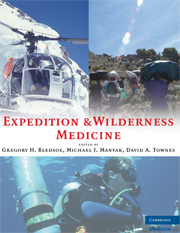Book contents
- Frontmatter
- Contents
- Contributors
- Foreword
- Preface
- Acknowledgments
- PART I EXPEDITION PLANNING
- PART II EXPEDITIONS IN UNIQUE ENVIRONMENTS
- PART III ILLNESS AND INJURIES ON EXPEDITIONS
- 24 General Medical
- 25 The Diarrhea of Travelers
- 26 Malaria: Diagnosis, Prevention, and Treatment for the Traveler
- 27 Wild Animal Attacks and Injuries
- 28 Snake and Arthropod Envenoming
- 29 Hazardous Marine Life
- 30 Expedition Toxicology
- 31 Environmental Injuries
- 32 Penetrating and Explosive Wounds
- 33 Drowning and Submersion Injury
- 34 Evaluation and Acute Resuscitation of the Trauma Patient
- 35 Principles and Practice of Expedition Wound Management
- 36 Expedition Eye Injuries and Disorders
- 37 Dental Medicine on Expedition
- 38 Foot Injuries
- 39 Expedition Orthopedics
- 40 Expedition Self-Rescue and Evacuation
- 41 Aeromedical Evacuations
- APPENDIX The Expedition Medical Kit
- Index
31 - Environmental Injuries
from PART III - ILLNESS AND INJURIES ON EXPEDITIONS
Published online by Cambridge University Press: 05 March 2013
- Frontmatter
- Contents
- Contributors
- Foreword
- Preface
- Acknowledgments
- PART I EXPEDITION PLANNING
- PART II EXPEDITIONS IN UNIQUE ENVIRONMENTS
- PART III ILLNESS AND INJURIES ON EXPEDITIONS
- 24 General Medical
- 25 The Diarrhea of Travelers
- 26 Malaria: Diagnosis, Prevention, and Treatment for the Traveler
- 27 Wild Animal Attacks and Injuries
- 28 Snake and Arthropod Envenoming
- 29 Hazardous Marine Life
- 30 Expedition Toxicology
- 31 Environmental Injuries
- 32 Penetrating and Explosive Wounds
- 33 Drowning and Submersion Injury
- 34 Evaluation and Acute Resuscitation of the Trauma Patient
- 35 Principles and Practice of Expedition Wound Management
- 36 Expedition Eye Injuries and Disorders
- 37 Dental Medicine on Expedition
- 38 Foot Injuries
- 39 Expedition Orthopedics
- 40 Expedition Self-Rescue and Evacuation
- 41 Aeromedical Evacuations
- APPENDIX The Expedition Medical Kit
- Index
Summary
Human beings can survive weeks without food, days without water, but only hours without heat. Humans must, at all costs, preserve and protect their internal temperature, for it holds the key to all their life functions. The human body is a mass of billions of exquisitely sequenced chemical reactions all of which are temperature-sensitive. Individual changes in the cadence of those reactions will quickly lead to internal chaos, like a symphony orchestra with each member playing at a different tempo. The timing, and thus the temperature, of these reactions is so critical that if body temperature varies by more than 4°F from 98.6°F, systems begin to malfunction, and the body's formidable defenses will start to crumble. A variation of 10–15°F, unless quickly reversed, will generally be fatal. This is a frightening thought when you consider that we live on a planet where, depending on location and season, we can be assaulted by temperature variations of 100°F or more.
THERMAL REGULATION
In temperate climates, air temperature is generally lower than body temperature, and, as a result, body heat is constantly being given off into the space around it. The rate of heat loss depends upon the temperature differential between the environment and the body. When the air is 16°F cooler than the body, the rate of heat production is exactly offset by the rate of heat loss. This means that a resting human body will be in optimum heat balance when the outside temperature is 82°F.
- Type
- Chapter
- Information
- Expedition and Wilderness Medicine , pp. 479 - 491Publisher: Cambridge University PressPrint publication year: 2008



